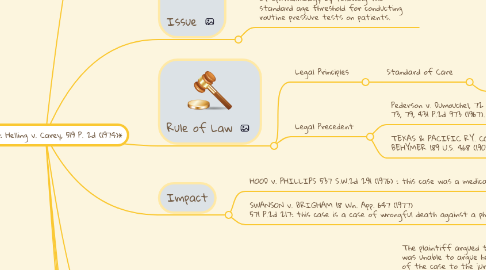
1. Facts
1.1. Parties
1.1.1. Petitioners: Morrison Helling and Barbara Helling (Plaintiff)
1.1.2. Respondents: Thomas Carey and Robert Laughlin (Defendants)
1.2. What Happened
1.2.1. The plaintiff suffers from primary open angle glaucoma . The plaintiff consulted the defendants for myopia in 1959. She was fitted with contact lenses.
1.2.2. The plaintiff consulted the defendants multiple times from 1963 concerning irritation caused by the contact lenses.
1.2.3. Dr. Carey tested the plaintiff's eye pressure and field of vision for the first time in October 1968 and diagnosed the plaintiff with glaucoma.
1.2.3.1. The plaintiff was 32 years old at the time of the diagnoses. Routine pressure tests for glaucoma are typically done for patients that are 40 years and over.
1.2.4. After consulting with other physicians, the plaintiff filed a complaint against the defendants alleging that she sustained severe and permanent damage to her eyes as a proximate result of the defendant's' negligence.
1.3. Procedural History
1.3.1. The trial court ruled in favor of the ophthalmologists.
1.3.2. An appeals court of Washington state affirmed the trial court's holding.
1.3.3. The plaintiff appealed the court of appeals ruling to the Supreme court of Washington.
2. Issue
2.1. Whether the ophthalmologist complied with the standard of care for the profession of ophthalmology by following the standard age threshold for conducting routine pressure tests on patients.
3. Application
3.1. Plaintiff's arguments
3.1.1. The plaintiff argued that she was unable to argue her theory of the case to the jury that the standard of care for the specialty of ophthalmology was inadequate to protect the plaintiff.
3.2. Defendant's arguments
3.2.1. The defendants argue that the standard of the profession and care, which does not require giving a pressure test to people below 40 years of age, is appropriate and absolves them from the negligence claim. This is due to the fact that glaucoma is so rare in the plaintiff's age group.
3.3. Court's application of the Rule
3.3.1. The court ruled that the reasonable standard that should have been followed included the routine pressure test, which is inexpensive and simple. The fact that the defendants did not conduct the pressure test means that they were negligent, which proximately resulted in the patient's glaucoma.
4. Conclusion
4.1. The court reversed judgment for the ophthalmologists because reasonable prudence required them to conduct a routine pressure test for glaucoma even though professional standards did not require them to do so.
5. Impact
5.1. HOOD v. PHILLIPS 537 S.W.2d 291 (1976) : this case was a medical malpractice case where the physician was not held liable for negligence based on the fact that the physician performed a procedure that was practiced by a minority of physicians in the field.
5.2. SWANSON v. BRIGHAM 18 Wn. App. 647 (1977) 571 P.2d 217: this case is a case of wrongful death against a physician. The court ruled that the expectation to perform care outside of the standard of care set in Helling v. Carey did not apply to the case because the facts were not similar.
6. Importance
6.1. A healthcare professional would care about the decision because it would make them more cognisant of looking for other issues outside of the standard of care of the patient. This could mean doing routine checks for patients that may not fit the profile of an ailment or disease.
7. Influence
7.1. The ruling impacts the way that medical students are taught their respective specialties. Students may be taught to adapt their standard of care to a wider scope depending on the patient's chief complaint.
7.2. The ruling also impacts medical practice insurance liabilities. Due to the ruling, medical malpractice insurers Must insure for instances where the practitioner was following the standard of their profession.
8. Rule of Law
8.1. Legal Principles
8.1.1. Standard of Care
8.1.1.1. Typically, the standard of care for ophthalmologists calls for routine pressure tests for glaucoma are done for patients that are 40 years or older.
8.2. Legal Precedent
8.2.1. Pederson v. Dumouchel, 72 Wn.2d 73, 79, 431 P.2d 973 (1967).
8.2.1.1. This medical malpractice case demonstrated that the ophthalmologists should not be expected to provide a higher standard of care than the the degree of care and skill which is expected of the average practitioner in the class to which he belongs, acting in the same or similar circumstances.
8.2.2. TEXAS & PACIFIC RY. CO. v. BEHYMER 189 U.S. 468 (1903)
8.2.2.1. This case brought by an employee that suffered injury against the railroad company. The ruling opinion stated that in cases of what ought to be done, a standard of reasonable prudence prevails, whether or not it is complied with or not.

